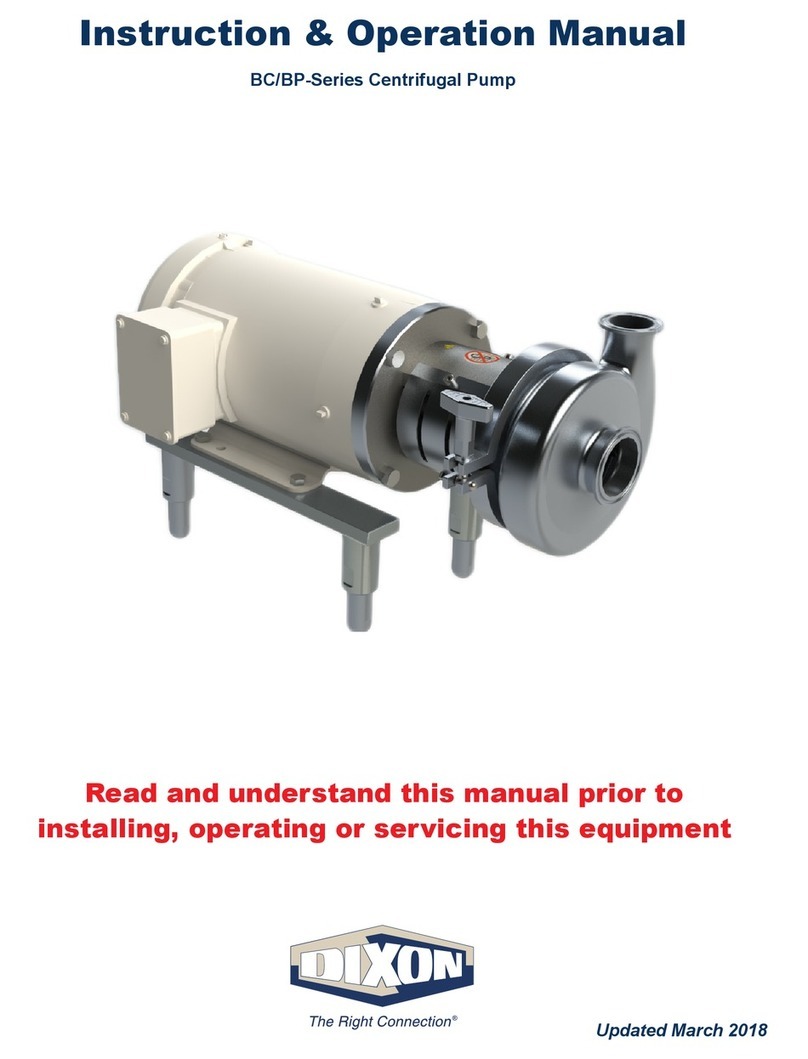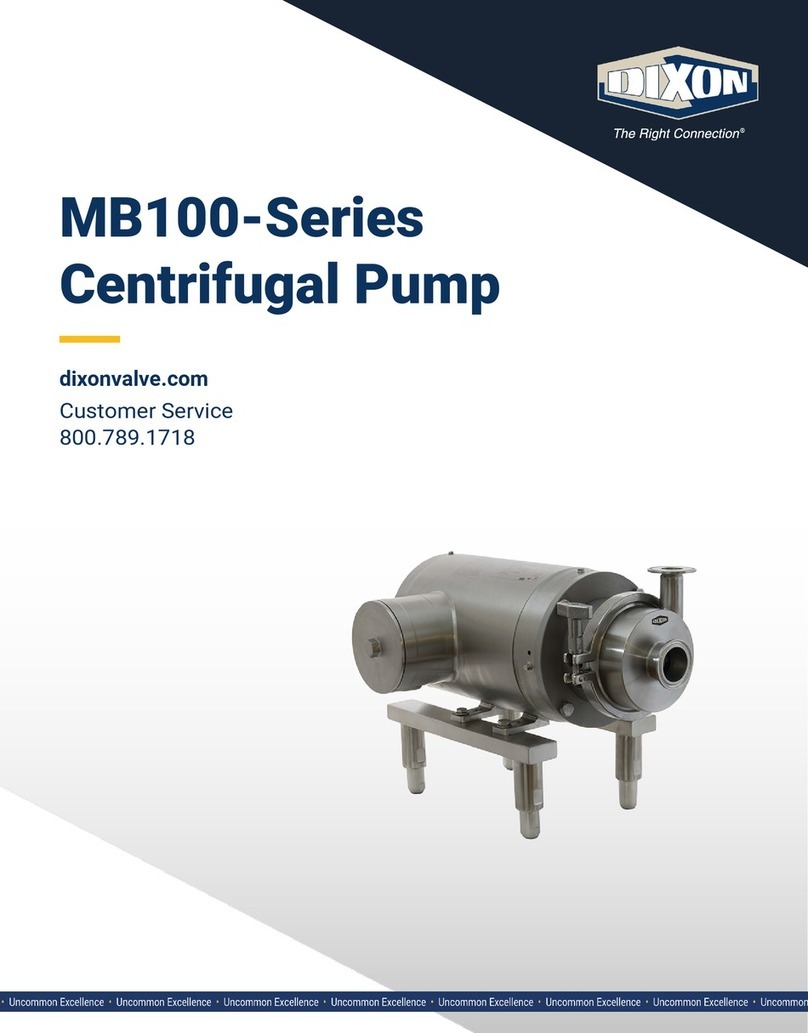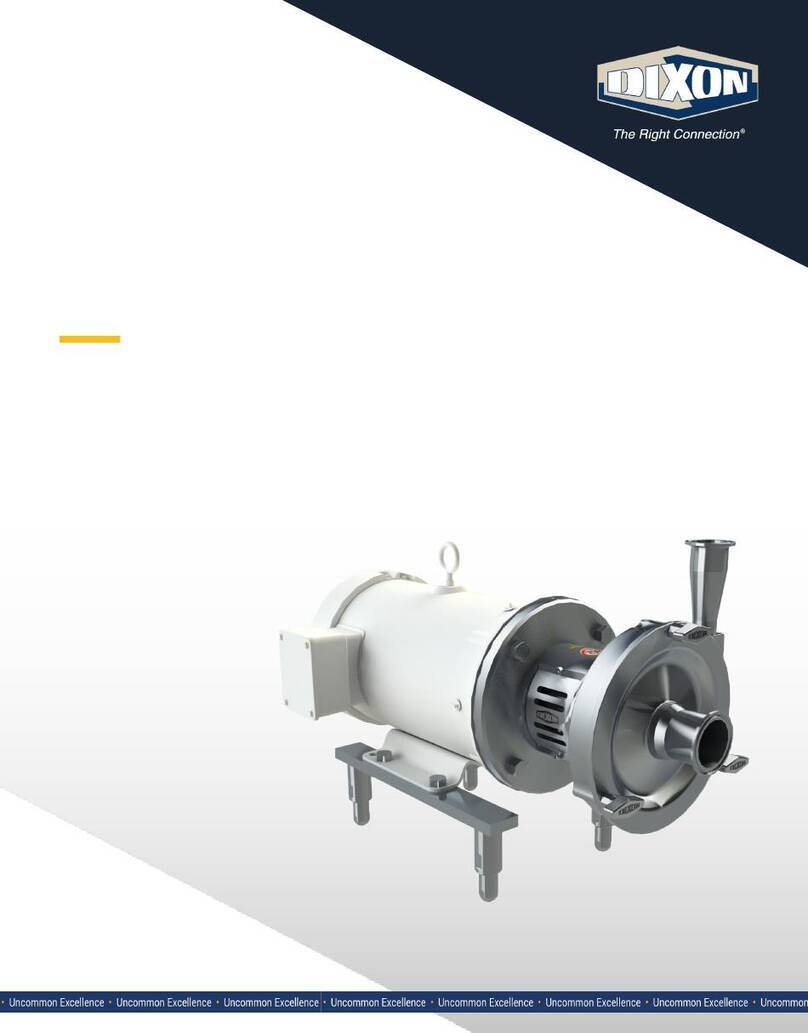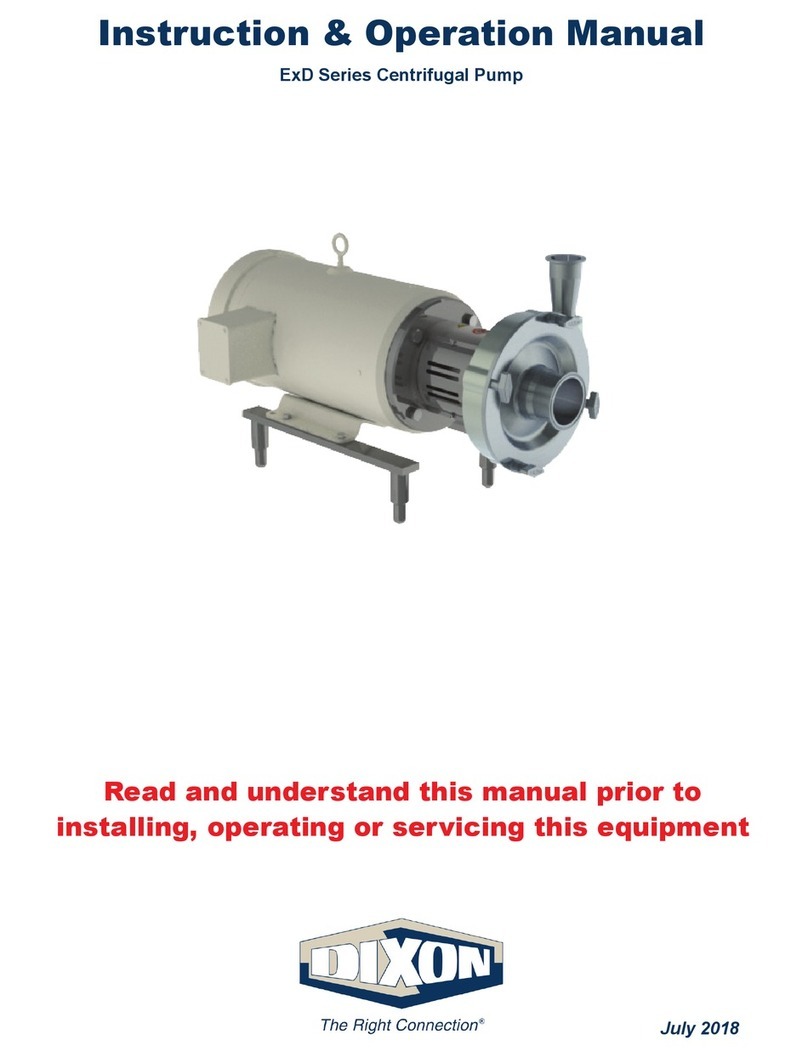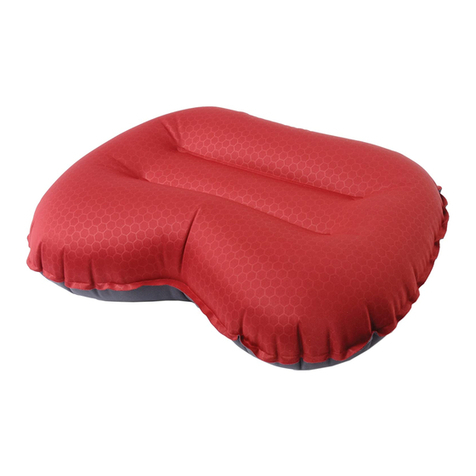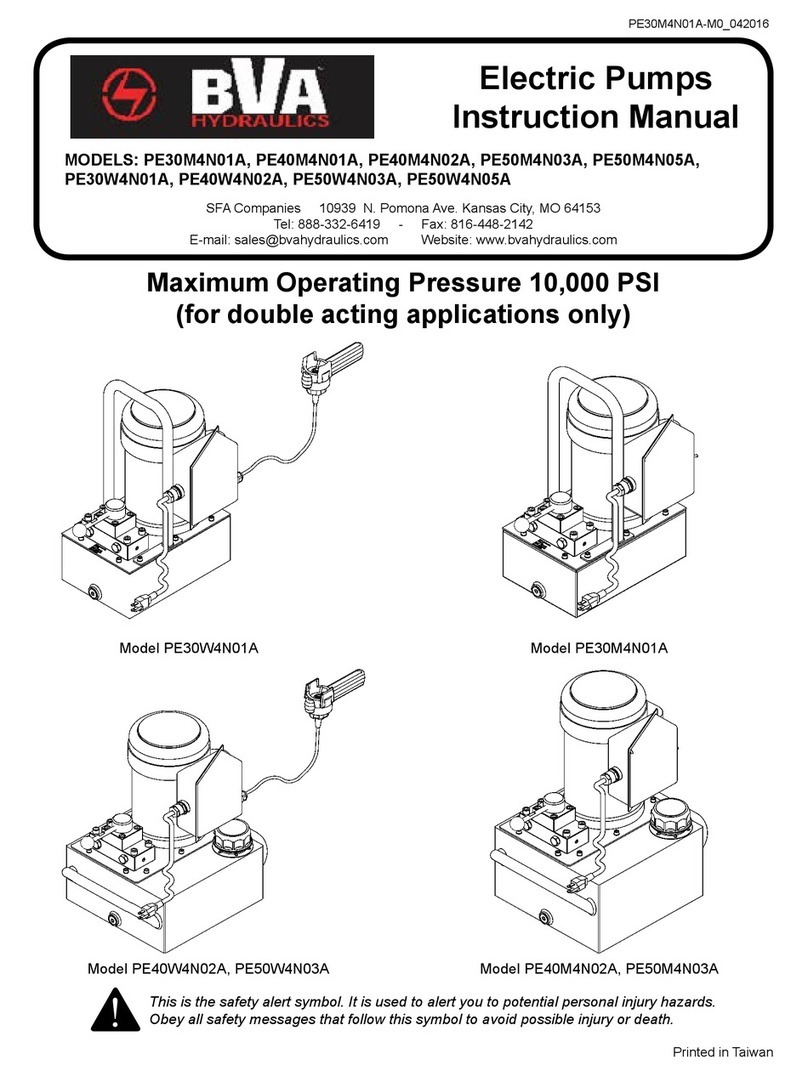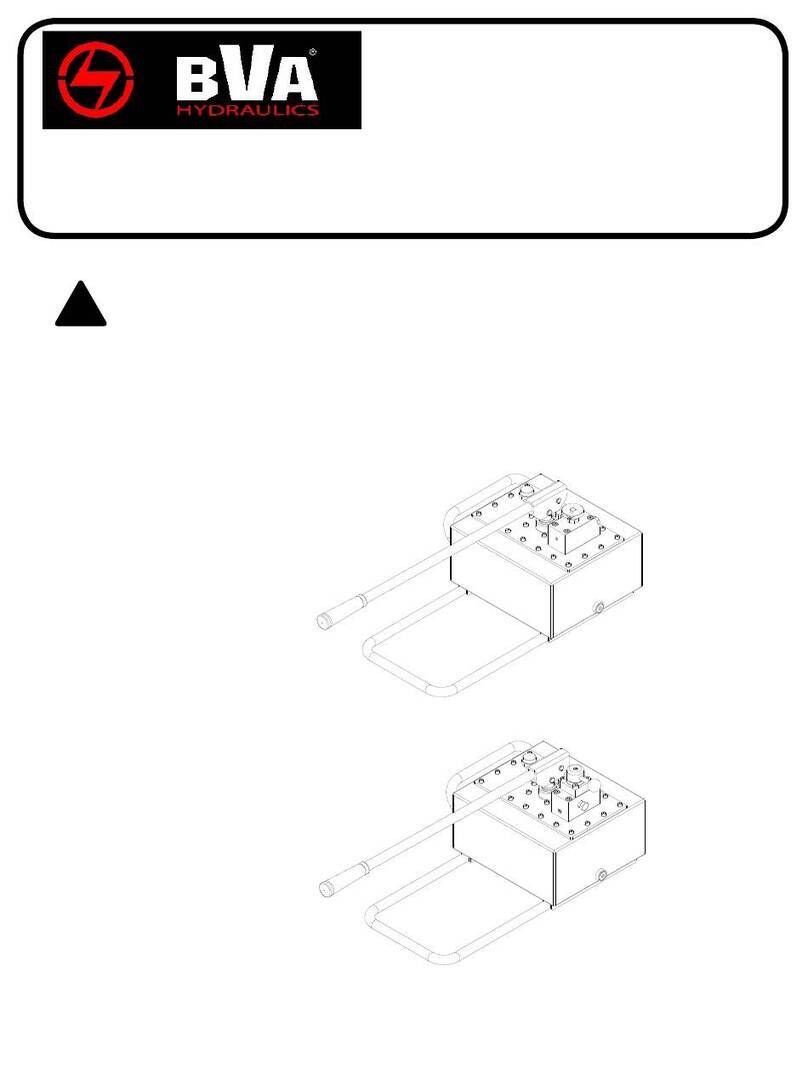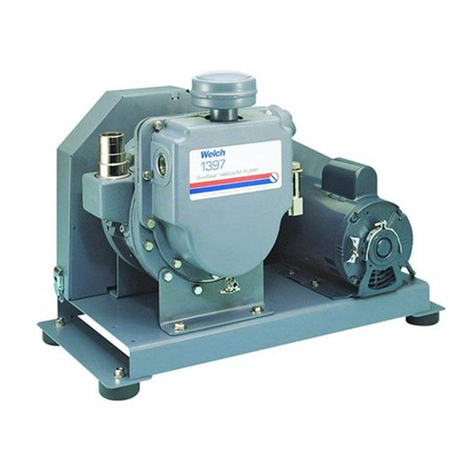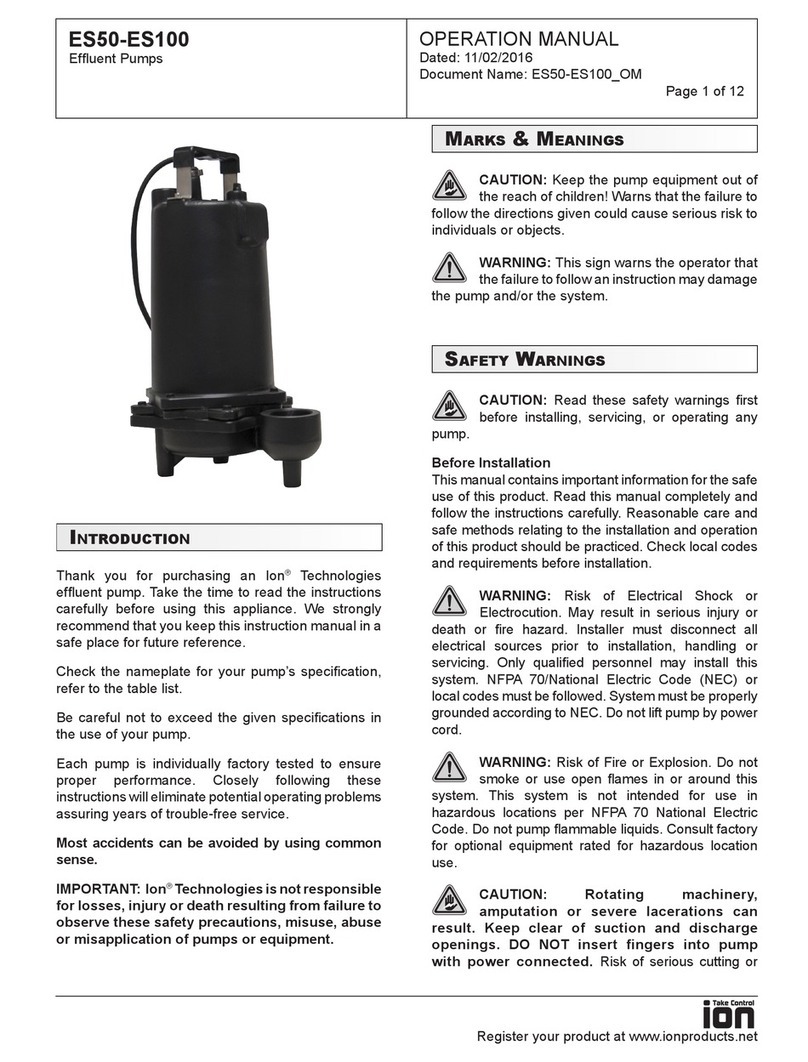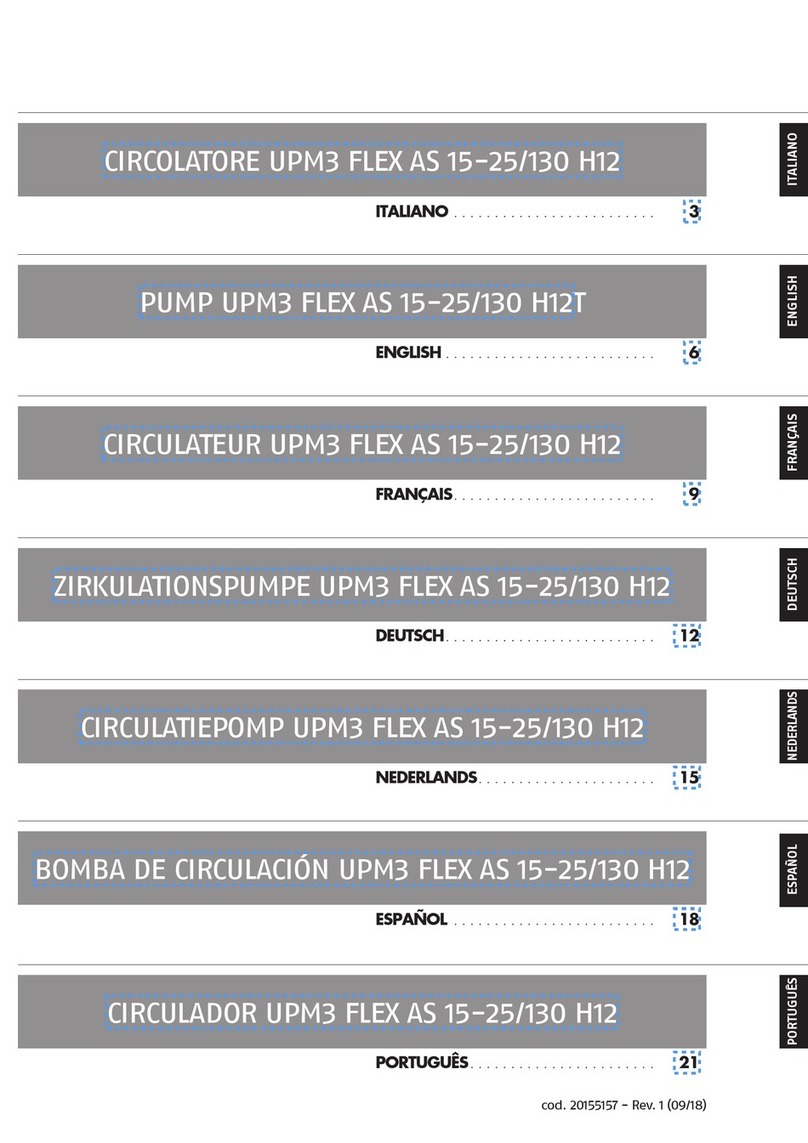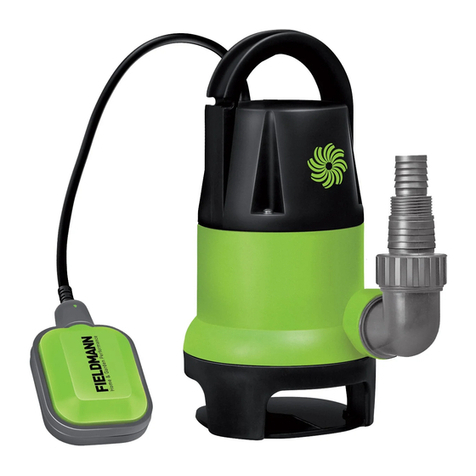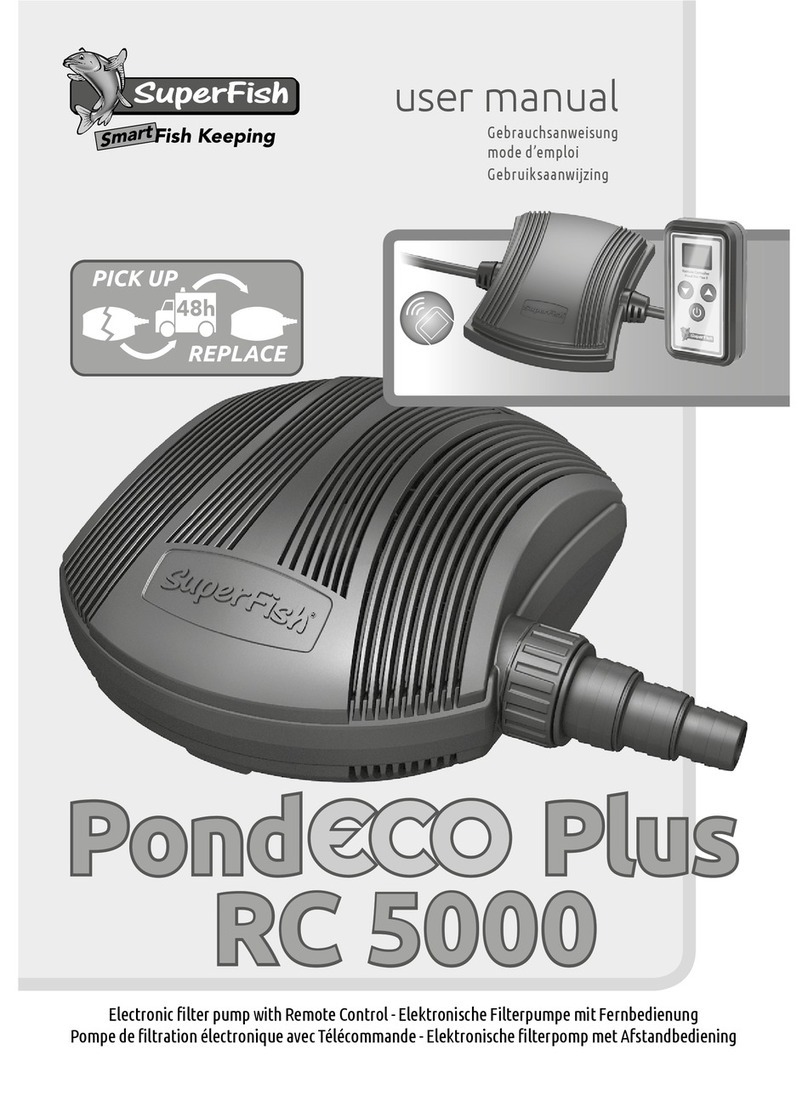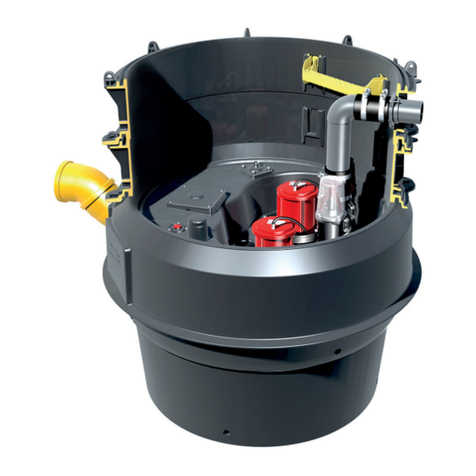Dixon Bradford BC114 Installation instructions manual

Instruction & Operation Manual
Read and understand this manual prior to
installing, operating or servicing this equipment
BC-Series Centrifugal Pump
Updated March 2012

2Instruction & Operation Manual800.789.1718
Table of Contents
Safety .......................................................2
Care of Stainless Steel.............................3
Introduction...............................................4
Mechanical Specications ........................5
Dimensions............................................6-7
Installation ...........................................8-14
Unpacking..........................................8
Tools needed .....................................8
'D' seal pump assembly..................8-9
'DG' seal pump assembly ...........10-11
Location ........................................... 11
Leveling ........................................... 11
Piping guidelines.........................12-14
General .....................................12
Suction.................................12-13
Discharge..................................13
Valve location............................14
Electrical.................................................14
Safety Information
The following DANGER, WARNING and CAUTION signs are contained in this manual.
To avoid serious injury and/or possible damage to equipment, pay attention to these
messages.
Hazards or unsafe practices which could result in severe personal injury or
death. The word DANGER is used in the most extreme cases.
Hazards or unsafe practices which could result in minor or moderate injury.
May also be used to alert against an unsafe operating or maintenance
practice.
Indicates a potentially hazardous situation which, if not avoided, could result
in death or serious injury.
Use only replacement parts and devices recommended by the manufacturer to maintain the
integrity of the equipment. Make sure the parts are properly matched to the equipment series,
model, serial number and revision level of the equipment.
Safety labels are placed on every pump. Do not remove any labeling on any BC-series pump.
Replace any label that is missing.
DO NOT modify any Bradford™ product. Non-factory modications could create hazardous
conditions and voids all warranties. DO NOT attempt to use a Bradford™ product in any
application that exceeds the product rating.
Operation...........................................15-17
Priming the Pump .......................15-16
Starting the Pump............................17
Stopping the Pump ..........................17
Maintenance......................................17-19
Scheduled Maintenance ..................17
Disassembly & Inspection................18
Seal Maintenance & Repair.............19
Troubleshooting.................................20-21
Model No.s & Part No.s.....................22-25
Pump model No.s ............................22
Motor model No.s ............................23
Part number key ..............................24
Common parts .................................24
Variable parts...................................25
Repair Kits ..................................26-27
Warranty .................................................28

PUMP
3Instruction & Operation Manual 800.789.1718
Care of Stainless Steel
The stainless steel components in Dixon Sanitary equipment are machined, welded and assembled by skilled craftsmen using
manufacturing methods that preserve the corrosion-resistant quality of the stainless steel.
Retention of corrosion-resistant qualities under processing conditions requires regular attention to the precautions listed below.
1. Regularly check all electrical devices connected to the equipment for stray currents caused by
improper grounding, damaged insulation or other defects. Corrosion: Pitting often occurs when
stray currents come in contact with moist stainless steel.
2. Never leave rubber mats, ttings, wrenches, etc. in contact with stainless steel. Corrosion: Pitting or galvanic action.
Objects retard complete drying, preventing air from reforming the protective oxide lm. Galvanic corrosion occurs when
two dissimilar metals touch when wet.
3. Immediately rinse equipment after use with warm water until the rinse water is clear. Clean the equipment (manual or
CIP) as soon as possible after rinsing. Corrosion: discoloration, deposits, pitting. Product deposits often cause pitting
beneath the particles.
4. Use only recommended cleaning compounds. Purchase chemicals from reputable and responsible chemical
manufacturers familiar with stainless steel processing equipment, they continuously check the effects of their products
on stainless steel.
5. Use cleaning chemicals exactly as specied by the manufacturer. Do not use excessive concentrations, temperatures
or exposure times. Corrosion: Pitting, discoloration, stress cracks. Permanent damage often occurs from excessive
chemical concentrations, temperatures or exposure times.
6. For manual cleaning, use only soft non-metallic brushes, sponges or pads. Brush with the grain on polished surfaces,
avoid scratching the surface. Corrosion: Pitting, scratches. Metal brushes or sponges will scratch the surface and
promote corrosion over a period of time. Metal particles allowed to remain on a stainless steel surface will cause pitting.
7. Use chemical bactericides exactly as prescribed by the chemical manufacturer in concurrence with local health
authority. Use the lowest permissible concentration, temperature and exposure time possible. Flush immediately after
bacterial treatment. In no case should the solution be in contact with stainless steel more then 20 minutes. Corrosion:
Protective lm destroyed. Chlorine and other halogen bactericides can destroy the protective lm. A few degrees
increase in temperature greatly increases chemical activity and accelerates corrosion.
8. Regularly inspect the joints in pipelines. Be sure all connections are tight tting without binding. Corrosion: Crevice
corrosion. Small crevices caused by improperly seated gaskets will promote crevice corrosion. Stainless steel under
stress will develop stress cracking especially in the presence of bactericides containing chlorine.
9. Regularly inspect equipment for surface corrosion (i.e. pitting deposits, stress cracks, etc.). If deposit or color corrosion
is detected, remove it immediately using mild scouring powder and detergents. Rinse thoroughly and allow to air dry.
Review production and cleaning procedures to determine the cause. Note: If corrosion is not removed, the protective
lm cannot be restored and corrosion will continue at an accelerated rate.

4Instruction & Operation Manual800.789.1718
Introduction
This manual contains installation, operation, cleaning, repair instructions, model numbering structure and parts list for the
Bradford™ BC-Series centrifugal pumps.
The Bradford™ BC-Series centrifugal pump is made up of two sections, the pump components (uid end) and the motor
assembly. The pump is mounted on the drive motor with an adapter and is coupled to the motor with a stainless steel stub
shaft. The pump impeller is mounted on the stub shaft and is secured with a oating impeller retainer pin.
The casing is joined to the adapter by a heavy duty cast clamp. This design allows the volute outlet to be rotated to various
positions.
An adjustable leg kit is an option for mounting the drive motor and is designed to meet sanitary requirements. This
conguration simplies the installation and ease of leveling.
Part No. Description
P1 Casing
P2 Impeller
P6A Shaft Set Screws
P6E Stub Shaft
P11 'D' Back Plate
P11F Back Plate Pins*
P24 Impeller Retainer
P40 Deector
P71 Adapter
P71A Adapter Pins*
P75 Clamp Assembly
P80 Carbon Seal
P80A Seal Cup
P80B Seal O'Ring
P80C Spring
P80K Seat Screw
P80L Drive Collar
P90 Casing Gasket
P131 Guard Assembly
P207 Leg Kit
Part No. Description
P11H 'DG' Back Plate
P17J Gland Ring
P17K Gland Bolt
P17M Washers
P80N Seal Seat
P80P Outboard Gasket
P80R Inboard Gasket
DG Seal
*not used on BC114/214 Models
Part No. Description
P5 'DG' Back Plate
F Seal

PUMP
5Instruction & Operation Manual 800.789.1718
Mechanical Specications
•Motor: standard C-face, 1750 and 3450 RPM, TEFC and
washdown, foot mounted
•Additional motor types available upon request
•Mounting: pump head mounted to a C-Face motor
Motors and Mounting
•Nominal Capacity: up to 780 GPM
•Temperature: 32°F to 212°F, consult factory for other
temperatures
•Nominal speed: up to 3500 RPM - 60 Hz
Performance Characteristics
•Volute: 316L stainless steel
•Impeller: CF8M (316) stainless steel
•Backplate: 316L stainless steel
•Stub Shaft: 316L stainless steel
•Adapter: 304 stainless steel
•Optional Leg Kit: 304 stainless steel
•Seal Types: externally balanced 'D','DG', and 'F' with
clamped in seat
•Rotary Seal Material: carbon and silicon carbide
•'DG' Seal Seat Material: silicon carbide, ceramic and
tungsten carbide
•Elastomers: Buna, EPDM, silicone and FKM
•Finish: sanitary polish 32RA
Standard Construction 1750 RPM
3500 RPM

6Instruction & Operation Manual800.789.1718
Dimensions
Pump
Model
Frame
Size X Y CP E HDmax J L
BC114
56C 3.63 1.63 18.00 3.00 7.00 10.60 6.22
140TC 3.63 1.63 18.20 4.00 7.00 10.80 6.22
180TC 3.63 1.63 18.80 4.50 8.00 11.00 6.78
BC216
56C 4.50 1.94 16.26 3.00 7.00 8.81 6.06
140TC 4.50 1.94 18.70 4.00 7.00 11.25 6.06
180TC 4.50 1.94 22.00 4.50 8.00 12.00 6.69
210TC 4.50 1.94 25.70 5.50 8.75 13.90 7.81
250TC 4.50 1.94 31.40 10.00 9.75 15.70 8.50
BC218
&
BC328
140TC 5.50 1.94
2.25 * 18.50 4.00 7.00 11.10 6.31
180TC 5.50 1.94
2.25 * 22.50 4.50 8.00 12.00 6.94
210TC 5.50 1.94
2.25 * 26.30 5.50 8.75 14.50 7.31
250TC 5.50 1.94
2.25 * 31.20 10.00 9.75 15.50 8.19
280TC 5.50 1.94
2.25 * 33.80 11.00 10.50 15.60 8.81
320TC 5.50 1.94
2.25 * 36.70 12.00 11.50 17.90 9.69
All dimensions are given in inches
* only applies to the BC328

PUMP
7Instruction & Operation Manual 800.789.1718
Dimensions
Pump
Model INLET OUTLET Z
BC114 1.5 1.5 2.63
BC214 2
BC216 2 1.5 3.69
BC516 2.5
BC218 2 1.5 4.75
BC318 3
BC328 3 2 4.75
BC428 4
Frame
Size AB Conduit Entry
diameter W
56C 5.53 0.87 4.85
140TC 5.53 0.87 5.50
180TC 7.00 0.87 7.50
210TC 7.62 0.87 8.50
250TC 10.80 2.05 10.00
280TSC 13.40 2.36 11.00
320TSC 14.37 2.36 12.50
All dimensions are approximate;
for exact dimensions contact Dixon Sanitary
All dimensions are given in inches

8Instruction & Operation Manual800.789.1718
Installation
Unpacking
Carefully unpack all parts of the pump and inspect for damages that may have occurred during shipment. Report any
damages to the carrier immediately.
The ports on the pump are protected with a plastic cover. If any covers are missing or damaged, inspect the ports on the
pump thoroughly for any damage.
Tools Needed
If you have purchased a uid end and will be assembling the pump to a motor the following tools will most likely be used:
'D' Seal Pump Assembly
•Flat head screw driver
•Allen wrenches
•Open ended wrenches
•Feeler gauge
•Calipers
•Pliers
•Rubber mallet
1. Install the adapter onto the motor using (4) bolts and (4) lock washers. Position
the adapter such that the threaded seal ush adapter hole is located on the top.
2. Install adapter pins by tapping the knurled end into the holes until ush with the
outside diameter of the adapter face.
3. Stub shaft alignment:
a. Make sure that the key is in the motor shaft, then slide stub shaft onto motor
shaft. Do not tighten set screws.
b. Set back plate on adapter face.
c. Slide impeller onto stub shaft end.
d. Using feeler gauge between back plate and impeller position stub shaft so
that the gap is equal to .060" ± .010. (see gure no.1)
e. Tighten set screws on stub shaft.
f. Remove impeller and back plate.
4. Slide deector over shaft large end rst until it locks into position at the base of
the stub shaft.
5. Slide drive collar large end rst over the stub shaft. Position collar and set
dimension 'A' to 0.6". (see gure no.2)
6. Tighten collar set screws.
a. Place seal spring over stub shaft and down onto the drive collar.
b. Place cup on top of the spring with slot lining up with extrusion on drive collar.
c. Place seal o-ring into the back of the carbon seal and slide the seal o-ring
assembly onto stub shaft, lining the notches in the carbon seal up with the
pins on the cup.
d. Check to make sure that slot in cup is still aligned with the extrusion in the
drive collar. (see gure no.3)
continued on next page ...
COLLAR
EXTRUSION
CUP
SLOT
Figure No. 1
Figure No. 2
Figure No. 3

PUMP
9Instruction & Operation Manual 800.789.1718
7. Screw back plate pins into back plate. (see gure no.4)
8. Position casing gasket on circumference of the back plate.
9. Check that both the seal face on the back plate and the seal face of the carbon seal
are completely clean. Even the oils from your skin are not acceptable on these two
surfaces. Clean faces thoroughly with a clean, lint free cloth.
10. Assemble back plate to adapter.
a. Place the back plate assembly onto the adapter. Put even pressure down on the
back plate until it is completely seated on the adapter. (see gure no.5)
b. Check that the drive collar extrusion is fully engaged in the slot on the cup.
c. Rotate the back plate so that the back plate pins engage the adapter pins, holding
it in place.
d. With black plate depressed completely to the adapter, inspect the spring to
insure there is some space between the coils. If the coil is too tight, repeat step
5 and add 0.05" to dimension 'A' and re-check spring coil. Repeat if necessary.
11. Install the impeller.
a. Insert the impeller retainer into the hole near the end of the stub shaft so that it is
centered in the shaft.
b. Slide the impeller onto the stub shaft.
c. Using a small hex key or screw driver push the impeller retainer so that it is
sticking out one end as far as it will allow, thus locking the impeller into place.
12. Close and seal the pump.
a. Place volute onto assembly with discharge outlet pointing in the desired position.
b. While applying sufcient pressure to bring adapter and volute together put on and
tighten clamp.
13. Attach and tighten guard assembly making sure that the seal ush tab on the adapter
lines up with the indent on the corresponding side of the guard.
Installation
'D' Seal Pump Assembly
... continued from previous page
A
B
A
B
Figure No. 4
Figure No. 5
Click here to visit the YouTube
assembly video for D Seal
Pumps
Scan this code on
your smart phone to
visit the YouTube
video for detailed
assembly instructions

10 Instruction & Operation Manual800.789.1718
Installation
'DG' Seal Pump Assembly
1. Install the adapter onto the motor using (4) bolts and (4) lock washers. Position
the adapter such that the treaded seal ush adapter hole is located on the top.
2. Stub shaft alignment:
a. Make sure that the key is in the motor shaft, then slide stub shaft onto motor
shaft. Do not tighten set screws.
b. Set back plate on adapter face.
c. Slide impeller onto stub shaft end.
d. Using feeler gauge between back plate and impeller position stub shaft so
that the gap is equal to .060" ± .010. (see gure no.6)
e. Tighten set screws on stub shaft.
f. Remove impeller and back plate.
3. Slide deector over shaft large end rst until it locks into position at the base of
the stub shaft.
4. Slide drive collar large end rst over stub shaft until it will not slide any further.
5. Tighten collar set screws.
a. Place seal spring over stub shaft and down onto the drive collar.
b. Place cup on top of the spring with slot lining up with extrusion on drive collar.
(see gure no.7)
c. Place seal o-ring into the back of the carbon seal and slide the seal o-ring
assembly onto stub shaft, lining the notches in the carbon seal up with the
pins on the cup.
d. Check to make sure that slot in cup is still aligned with the extrusion in the
drive collar. (see gure no.7)
6. Assemble 'DG' seal back plate. (see gure no.8)
7. Position casing gasket on circumference of the back plate.
8. Check that both the seal face on the back plate and the seal face of the carbon
seal are completely clean. Even the oils from your skin are not acceptable on
these two surfaces. Clean faces thoroughly with a clean, lint free cloth.
9. Assemble back plate to adapter.
a. Place the back plate assembly onto the adapter. Put even pressure down on
the back plate until it is completely seated on the adapter.
b. Check that the drive collar extrusion is fully engaged in the slot on the cup.
10. Install the impeller.
a. Insert the impeller retainer into the hole near the end of the stub shaft so that
it is centered in the shaft.
b. Slide the impeller onto the stub shaft.
c. Using a small hex key or screw driver push the impeller retainer so that it is
sticking out one end as far as it will allow, thus locking the impeller into place.
11. Close and seal the pump.
a. Place volute onto assembly with discharge outlet pointing in the desired
position.
b. While applying sufcient pressure to bring adapter and volute together put on
and tighten clamp. continued on next page ...
COLLAR
EXTRUSION
CUP
SLOT
Figure No. 6
Figure No. 7
Figure No. 8

PUMP
11Instruction & Operation Manual 800.789.1718
Installation
'DG' Seal Pump Assembly
... continued from previous page
12. Attach and tighten guard assembly making sure that the seal ush tab on the adapter
lines up with the indent on the corresponding side of the guard.
•Pump will perform at its best when located as close as possible to the liquid supply.
• Supply piping should be short and straight to insure the pump has an adequate supply of liquid to it at all times.
•The pump should be located in an area where it is easy to inspect, do preventative maintenance or repair.
• Motor must be in area where it will not be ooded.
Location
The pump can be easily leveled by installing the optional leg
kit. Loosen the set screws and adjust the leg to the proper
level, then tighten the set screws when level. (see the
diagram to the right)
Optional Leg Kit Installation and Leveling
Scan this code on
your smart phone to
visit the YouTube
video for detailed
assembly instructions
Scan this code on
your smart phone to
visit the YouTube
video for detailed
assembly instructions
Click here to visit the YouTube
assembly video for BC series
pumps with DG seals
Click here to visit the YouTube
installation video for the BC Series
pump optional leg kit

12 Instruction & Operation Manual800.789.1718
Installation
Piping: General Guidelines
Improper piping can lead to a number of problems
with pump performance which will lead to increased
maintenance costs.
•Insure piping is independently supported at both the
suction and discharge ports of the pump.
(see the diagram to the right)
•Piping must be properly aligned to prevent any strain on
pump volute.
•Try to have as few bends as possible in all piping.
Piping: Suction Guidelines
•Make sure line sizes used are equal to or larger than suction side (supply side) port connections on pump.
•Suction side needs to be short and straight as possible. Any restrictions will affect the NPSHa. Adequate NPSHa must be
insured.
•Maintain a straight length of pipe at a minimum of 8 x diameters long at the pump inlet.
(see the diagram below)
•To prevent air leaks, insure all joints in suction line are well sealed.
PROXIMITY
TO
VOLUTE
TUBING
HANGER
TUBING
HANGER
DIAMETER
MINIMUM LENGTH = 8 x DIAMETER
continued on next page ...

PUMP
13Instruction & Operation Manual 800.789.1718
•Use an eccentric reducer with straight side up to prevent
air pockets from forming which will result in a decrease in
pump efciency.
(see the diagram to the right)
•To prevent a high point in the suction line resulting
in an air pocket being formed affecting proper pump
performance, horizontal suction pipes must have a
gradual rise to the pump.
Installation
Piping: Suction Guidelines
Piping: Discharge Guidelines
•Discharge side should be short and direct. Use a minimal number of restrictions.
(see the diagram to the right)
•Vertical or top horizontal pump discharge position is preferred.
(see the diagram at the bottom)
•While increasing the discharge side line size is recommended, please note:
>Using too large of a line size will lead to pump overload.
>Using a smaller than recommend line size will increase the pump head but lower the
ow.
•Types of reducers to use:
>If vertical discharge – concentric
>If horizontal discharge – eccentric with straight side down
... continued from previous page
ECCENTRIC
REDUCER
CONCENTRIC
REDUCER
DIAMETER
MINIMUM LENGTH
= 10 x DIAMETER
BETWEEN
0° & 90°

14 Instruction & Operation Manual800.789.1718
•An isolation valve should be installed at both
the suction and discharge sides of the pump.
This will allow you to remove the pump for
preventative maintenance or repair without the
need to drain your system.
(see the diagram to the right)
• If pump is not in a ooded suction condition,
install either a foot valve or system check valve
to insure pump volute is ooded for priming.
• In order to provide pump ow rate control,
a control valve should be installed in the
discharge piping to prevent motor overload.
MINIMUM LENGTH
= 10 X DIAMETER
DIAMETER
CHECK
VALVE
CONTROL
VALVE
MINIMUM LENGTH = 8 X DIAMETER
DIAMETER
ISOLATION
VALVE
PSI
Installation
Piping: Valve location
All power must be off and locked out during the installation process.
Only registered electricians should do the electrical installation.
Electrical
•Follow motor manufacturer’s installation procedures.
•Verify motor nameplate data is compatible with existing
electrical supply.
•Verify pump rotation. An arrow sticker is supplied
with every pump to show correct pump rotation. If the
arrow stickers are missing, contact Dixon Sanitary for a
replacement.
•Correct rotation is counter clockwise when facing pump
inlet connection.

PUMP
15Instruction & Operation Manual 800.789.1718
Operation
Priming the Pump
SUPPLY SOURCE
ABOVE PUMP LEVEL
CHECK
VALVE
CONTROL
VALVE
ISOLATION
VALVE
To avoid damage to the pump, the pump casing must be ooded with
liquid BEFORE starting the pump.
Fluid supply above the pump:
1. Open supply line isolation valve.
2. Vent any entrapped air by opening the discharge valve.
3. After volute is ooded, start pump.
If the uid supply is below the pump see page 16.
Note: This is not a self priming pump. Other means must be installed to prime the pump.

16 Instruction & Operation Manual800.789.1718
Operation
Priming the Pump
CHECK
VALVE
CONTROL
VALVE
ISOLATION
VALVE
FOOT
VALVE
EXTERNAL PRIMING
SUPPLY LINE
Fluid supply below the pump:
1. Close discharge valve and open air vents.
2. Open valve in external priming supply line. Close once
liquid ows from vent valves.
3. Close vent valves.
4. Turn off priming supply line.
5. Start pump.
If the uid supply is above the pump see page 15.
Note: It is recommended to use a foot/check valve system to keep the pump primed. Otherwise the pump must be primed
before each operation.

PUMP
17Instruction & Operation Manual 800.789.1718
Operation
Starting the Pump
1. Insure pump suction is ooded using either method as explained in the previous priming section.
2. Check for any closed valves or obstructions in the suction and discharge lines.
3. Start the motor.
4. Verify liquid is owing and there is no piping connection or mechanical seal leaks.
5. Adjust throttling valve on discharge line to desired ow.
Stopping the Pump
1. Shut off power to motor.
2. Suction and discharge valves are to be shut off.
Be advised the pump does not act as a shut off valve. The liquid will ow freely though the pump.
Maintenance
Scheduled Maintenance
Preventative maintenance will increase the life of your pump. Documentation of any maintenance will help to diagnose
potential problems and help in determining solutions.
1. Inspect casing for:
•Unusual wear
•Damage to ports
2. Inspect casing gasket for
•Wear
•Damage
Scheduled maintenance will require disassembly of the pump and the following:
3. Inspect impeller for
•Unusual wear
•Damage
4. Inspect mechanical seal for wear
5. Inspect shaft for
•Straightness
•Tightly installed
•Unusual pump or motor noise
•Excessive vibration
•Seal leakage
•Piping leaks at ports
Monitor pump throughout its use for any of the following problems: see troubleshooting guide on pages 20-21, for possible
solutions.
• Unexpected change in ow or head
•Temperature changes
•Excessive power consumption
•Overheating motor

18 Instruction & Operation Manual800.789.1718
Maintenance
Disassembly & Inspection
1. Turn off and lock out power to pump motor.
2. Isolate pump from system.
3. Relieve system pressure.
4. Remove suction and discharge lines from volute.
5. Remove seal guard assembly.
6. Loosen clamp assembly and remove.
7. Remove casing and inspect for unusual wear or port damage.
8. Push back impeller and center impeller retainer in the stub shaft.
9. Remove impeller and inspect for unusual wear or damage.
10. Remove impeller retainer.
11. Rotate back plate to disengage from adapter pins and remove.
12. See seal removal and inspection instructions on page 19.
13. Inspect shaft to insure straightness and that it is fastened securely to the motor shaft.
14. If stub shaft needs to be removed, remove deector rst.
15. If necessary remove stub shaft by loosening the two (2) set screws. If the shaft does not remove easily, use a pry bar on
the periphery of the base of the shaft.
Scan this code on
your smart phone to
visit the YouTube
video for
BC Series Disassembly D-Seal
Scan this code on
your smart phone to
visit the YouTube
video for
BC Series Disassembly DG-Seal
Click here to visit the YouTube
disassembly video for BC Series
pumps with D seals
Click here to visit the YouTube
disassembly video for BC Series
pumps with DG seals

PUMP
19Instruction & Operation Manual 800.789.1718
Maintenance
Seal Maintenance & Repair
See page 18 for disassembly instructions.
'D' Seal
1. When removing back plate inspect the stationary seal seat area for wear and/or damage.
Depending upon the extent of wear, the back plate may need to be resurfaced or
replaced.
2. Remove the carbon seal, o-ring, cup and spring.
3. Inspect carbon seal. Replace carbon seal if "A" dimension is less than 1/32".
(see the diagram to the right)
4. If carbon seal is replaced, drive collar setting should be veried and adjusted as needed.
'DG' Seal
1. When removing back plate inspect for any nicks or scratches.
2. Remove the four (4) bolts from the gland assembly.
3. Inspect 'DG' seal seat. This is a reversible part and if there is wear on one side you can
ip it to the other side until that side is worn.
4. Inspect gland ring and gaskets. Replace as needed.
5. Remove the carbon seal, o-ring, cup and spring.
6. Inspect carbon seal. Replace carbon seal if "A" dimension is less than 1/32".
(see the diagram to the right)
Return to disassembly instructions on page 18.
Scan this code on
your smart phone to
visit the YouTube
video for
BC Series Repair Kit #1
Scan this code on
your smart phone to
visit the YouTube
video for
BC Series Repair Kit #3
Scan this code on
your smart phone to
visit the YouTube
video for
BC Series Repair Kit #4
Scan this code on
your smart phone to
visit the YouTube
video for
BC Series DG Repair Kit
Click here to visit the YouTube
instruction video for the BC Series pump
Repair Kit # 1
Click here to visit the YouTube
instruction video for the BC Series pump
Repair Kit #3
Click here to visit the YouTube
instruction video for the BC Series pump
Repair Kit #4
Click here to visit the YouTube
instruction video for the BC Series pump
DG Repair Kit

20 Instruction & Operation Manual800.789.1718
Troubleshooting
Dixon Sanitary BC-Series pumps are manufactured and inspected to meet sanitary standards. Occasional problems may
arise. The following guide will help determine the possible cause and offer suggestions on corrections to maximize the
performance of your pump. In case of any electric motors issues, contact the motor manufacturer directly. If you have any
questions or concerns in regards to your BC-Series pump, we encourage you to contact Dixon Sanitary.
PROBLEM POSSIBLE CAUSE SUGGESTED ACTION
Not enough or no discharge No uid reaching pump. Need to prime pump. Installation of a priming system is
recommended.
Suction or discharge closed or
blocked.
Open suction. If plugged, shutdown pump and remove
blockage. If closed, check all valves for proper positions.
Motor rotation incorrect. Adjust motor electrical wiring to correct rotation.
Speed too slow (low voltage,
wrong frequency, wrong
motor).
Adjust voltage and frequency. Change motor if necessary.
Impeller damaged. Replace impeller.
Seal area or supply area has
an air leak.
Replace seal if needed. Check all other areas for air leaks
and repair.
Excessive air in material. Make any adjustments in system to insure excess air is
removed before material reaches the pump.
Discharge head too high. Adjust system to lower discharge head.
Suction lift too high. Adjust system to lower suction lift.
Insufcient NPSH (Net Positive
Suction Head) available.
Adjust system to provide correct NPSHa.
Impeller diameter not correct
for application.
Contact: Dixon Sanitary 800-789-1718
Not Enough Pressure Seal area or supply area has
an air leak.
Replace seal if needed. Check all other areas for air leaks
and repair.
Motor rotation incorrect. Adjust motor electrical wiring to correct rotation.
Speed too slow (low voltage,
wrong frequency, wrong
motor).
Adjust voltage and frequency. Change motor if necessary.
Excessive air in material. Make any adjustments in system to insure excess air is
removed before material reaches the pump.
Impeller diameter not correct
for application.
Contact: Dixon Sanitary 800-789-1718
Motor Overload/Excessive
Power Consumption
Discharge is too high. Restrict discharge to lower ow rate.
Impeller is binding. Inspect pump and check for any damage, misalignment or
interference. Replace any damaged or worn parts.
Seal binding. Inspect pump and replace any damaged or worn parts.
Discharge is too low. Increase discharge head.
Liquid is heavier or more
viscous than rating.
Contact: Dixon Sanitary 800-789-1718
Electrical supply, voltage or
frequency incorrect.
Make any adjustments needed up to replacing the motor.
Faulty electrical connections. Check wiring and repair/replace as necessary.
Overload heaters too small. Inspect and replace as necessary.
Defective motor. Contact motor manufacturer for possible warranty or repair.
Replace if needed.
Other manuals for Bradford BC114
1
This manual suits for next models
7
Table of contents
Other Dixon Water Pump manuals
